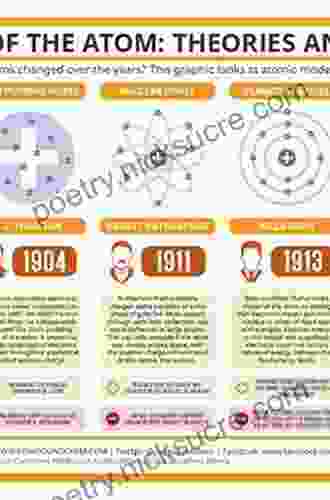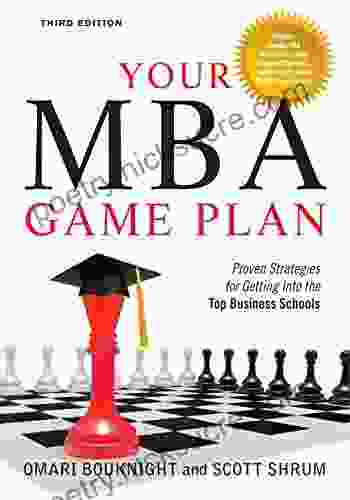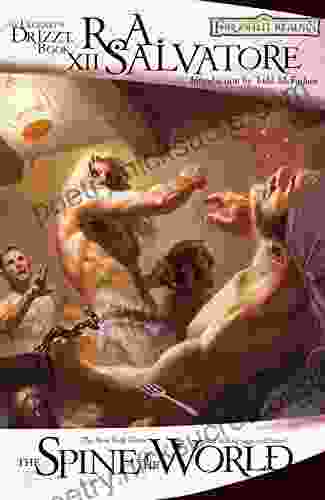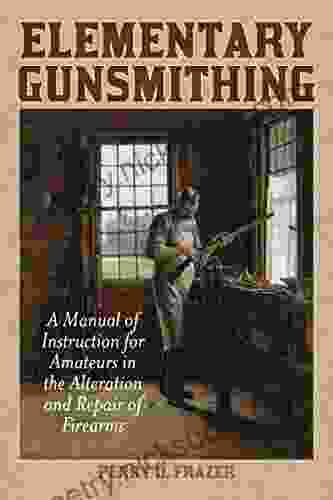Splitting the Second: The Story of Atomic Time

Time, as we perceive it, is a continuous and flowing entity. But beneath this seemingly seamless facade lies a world of precise measurement and meticulous engineering, where time is divided into increasingly smaller units with astonishing accuracy.
4.8 out of 5
| Language | : | English |
| File size | : | 3789 KB |
| Screen Reader | : | Supported |
| Print length | : | 199 pages |
The advent of atomic clocks in the mid-20th century marked a pivotal moment in the history of timekeeping. These groundbreaking devices harnessed the properties of atoms to create a new standard of time measurement, far more precise than any mechanical or astronomical methods that came before.
The Science of Atomic Clocks
The operation of atomic clocks relies on the fundamental principles of atomic physics. Atoms, being composed of electrons, protons, and neutrons, exhibit distinct resonant frequencies at which they absorb or emit electromagnetic radiation. This phenomenon, known as atomic resonance, is the cornerstone of atomic timekeeping.
Cesium-133, a particular isotope of cesium, has proven to be an exceptionally stable and reliable element for use in atomic clocks. The transition between two specific energy levels of cesium-133 atoms, known as the "hyperfine transition," occurs at a precisely defined frequency of 9,192,631,770 cycles per second. This frequency serves as the foundation of the International System of Units (SI) definition of the second.
By carefully controlling the environment and isolating cesium atoms from external influences, atomic clocks can maintain a remarkable level of precision. The best atomic clocks currently in operation can keep time to within a single second over hundreds of millions of years.
Applications of Atomic Time
The advent of atomic timekeeping has had a profound impact on countless scientific, technological, and societal domains. Its applications span a wide range, including:
- Navigation: Atomic clocks are essential for precise positioning and navigation systems such as GPS (Global Positioning System). By synchronizing satellites and ground stations with atomic time, GPS receivers can calculate their position with incredible accuracy.
- Communication: Atomic clocks ensure the reliable transmission and reception of electronic signals. In satellite communications, for instance, atomic clocks enable precise synchronization and prevent signal interference.
- Scientific Research: Atomic time facilitates precise measurements in various scientific fields, including astrophysics, particle physics, and geophysics. By measuring time intervals with extreme accuracy, scientists can gain insights into fundamental physical phenomena, such as the expansion of the universe and the behavior of subatomic particles.
- Metrology: Atomic clocks serve as the primary reference for calibrating and standardizing other timekeeping devices. They play a critical role in maintaining the accuracy of clocks in laboratories, industries, and everyday life.
Challenges and Advancements
While atomic clocks have achieved extraordinary levels of precision, ongoing research and development seek to push the boundaries of timekeeping even further. One significant challenge is to reduce the size and cost of atomic clocks, making them more accessible for a broader range of applications.
Another area of exploration involves the development of alternative atomic species for use in atomic clocks. Rubidium, hydrogen, and ytterbium are among the elements being investigated as potential candidates for even higher precision and stability.
Furthermore, researchers are exploring novel approaches to timekeeping, such as optical atomic clocks and atomic fountain clocks, which promise to surpass the accuracy of current cesium-based clocks.
The development of atomic clocks has revolutionized our understanding of time and its measurement. These remarkable devices have enabled unprecedented precision in various fields, from navigation and communication to scientific research and metrology. As research continues to advance the frontiers of atomic timekeeping, we can anticipate even more transformative applications in the years to come.
Splitting the second has not only improved the accuracy of time measurement but has also opened up new possibilities for scientific discovery, technological innovation, and societal progress.
4.8 out of 5
| Language | : | English |
| File size | : | 3789 KB |
| Screen Reader | : | Supported |
| Print length | : | 199 pages |
Do you want to contribute by writing guest posts on this blog?
Please contact us and send us a resume of previous articles that you have written.
 Fiction
Fiction Non Fiction
Non Fiction Romance
Romance Mystery
Mystery Thriller
Thriller SciFi
SciFi Fantasy
Fantasy Horror
Horror Biography
Biography Selfhelp
Selfhelp Business
Business History
History Classics
Classics Poetry
Poetry Childrens
Childrens Young Adult
Young Adult Educational
Educational Cooking
Cooking Travel
Travel Lifestyle
Lifestyle Spirituality
Spirituality Health
Health Fitness
Fitness Technology
Technology Science
Science Arts
Arts Crafts
Crafts DIY
DIY Gardening
Gardening Petcare
Petcare Sandy Bodeau
Sandy Bodeau Anna Wood
Anna Wood Tim Young
Tim Young J E Esslemont
J E Esslemont Sean Purchase
Sean Purchase Sparknotes
Sparknotes Fumio Sasaki
Fumio Sasaki Jennifer L Lopez
Jennifer L Lopez Martin N Seif
Martin N Seif Sharon Rowley
Sharon Rowley Zoe Moore
Zoe Moore Ray Eye
Ray Eye Reinhard Kleist
Reinhard Kleist Steve Schwartz
Steve Schwartz Richard Appleton
Richard Appleton Marjorie Savage
Marjorie Savage Julie A Ross
Julie A Ross Patricia Romanowski Bashe
Patricia Romanowski Bashe Frances Schultz
Frances Schultz Anne Sylvie Malbrancke
Anne Sylvie Malbrancke Charles J Sanders
Charles J Sanders Buddy Lee
Buddy Lee Dr Sarita Uhr
Dr Sarita Uhr Good Books
Good Books Darcie Little Badger
Darcie Little Badger Ian Moulding
Ian Moulding John O Sullivan
John O Sullivan Louise Katz
Louise Katz Philip Gibson
Philip Gibson Scott Allan
Scott Allan George James Grinnell
George James Grinnell Angela Saini
Angela Saini Johnny Chuong
Johnny Chuong Kendall Coyne
Kendall Coyne Ann Marie Brown
Ann Marie Brown Cathy Glass
Cathy Glass Lori L Tharps
Lori L Tharps Sandy Camillo
Sandy Camillo Helen Adrienne
Helen Adrienne Jack Perconte
Jack Perconte Stacey Williams
Stacey Williams Henry Dillon
Henry Dillon Ann Zaprazny
Ann Zaprazny Steven Callahan
Steven Callahan Lexi Ryan
Lexi Ryan Jessa Stone
Jessa Stone Jean Barbre
Jean Barbre Bethany Saltman
Bethany Saltman Peter Richmond
Peter Richmond Brian Daccord
Brian Daccord Ann Voskamp
Ann Voskamp Marva Boatman
Marva Boatman Helge Kragh
Helge Kragh Patricia Ladis
Patricia Ladis Arcturus Publishing
Arcturus Publishing Gilbert J Grant Md
Gilbert J Grant Md M Terese Verklan
M Terese Verklan Christina Henry De Tessan
Christina Henry De Tessan Neel Doshi
Neel Doshi Steven Yellin
Steven Yellin Rick Page
Rick Page John Gignilliat
John Gignilliat Bruce Lockwood
Bruce Lockwood Holly Chism
Holly Chism Monroe Wildrose
Monroe Wildrose Laurie Varga
Laurie Varga Ralph Cockburn
Ralph Cockburn Judy Corry
Judy Corry C J Brown
C J Brown Eddie Jones
Eddie Jones William P Young
William P Young Chris Bailey
Chris Bailey Dr Harper
Dr Harper Michael F Nenes
Michael F Nenes Anna Watson
Anna Watson Glen E Clarke
Glen E Clarke Christopher Seddon
Christopher Seddon Tanmay Mehta
Tanmay Mehta Sukhveer Singh
Sukhveer Singh William Goldman
William Goldman Lane Demas
Lane Demas Christine Field
Christine Field Peter Watson
Peter Watson Michael Hodgson
Michael Hodgson Joanna Wells
Joanna Wells Charles Dickens
Charles Dickens Sarah Stodola
Sarah Stodola Zach Hunter
Zach Hunter Shannon Vallor
Shannon Vallor Barry Dainton
Barry Dainton Joey Myers
Joey Myers Stefanie Japel
Stefanie Japel Mikael Lindnord
Mikael Lindnord Sally Annjanece Stevens
Sally Annjanece Stevens L J Smith
L J Smith Emily J Taylor
Emily J Taylor James F Twyman
James F Twyman Anna Ivey
Anna Ivey Sean Covey
Sean Covey John Murray
John Murray Paul Mendelson
Paul Mendelson Jennifer Kostick
Jennifer Kostick Michael Labossiere
Michael Labossiere Steve Oldenburg
Steve Oldenburg John Dunn
John Dunn Dave Whitlock
Dave Whitlock Skeleton Steve
Skeleton Steve James P Sethna
James P Sethna Jay Young
Jay Young Charlene Beswick
Charlene Beswick H Jerome Chapman
H Jerome Chapman Peyton Curley
Peyton Curley Jonathan Pd Buckley
Jonathan Pd Buckley Hill Harper
Hill Harper Lily Dunn
Lily Dunn Fox Fisher
Fox Fisher Finn Aagaard
Finn Aagaard Aaron Mahnke
Aaron Mahnke Annette Burns
Annette Burns Todd Radom
Todd Radom Emmett W Hines
Emmett W Hines Ling Seto
Ling Seto Roy M Wallack
Roy M Wallack David Soucie
David Soucie Will Kurt
Will Kurt Craig Ramsay
Craig Ramsay Victor Stringer
Victor Stringer Chase Hassen
Chase Hassen George Lakoff
George Lakoff Susan M Schneider
Susan M Schneider Maggie Downs
Maggie Downs Christopher T Coughlin
Christopher T Coughlin Horace Kephart
Horace Kephart Heidi Kreider
Heidi Kreider Matthew Locricchio
Matthew Locricchio Michael Witwer
Michael Witwer Elizabeth Wissner Gross
Elizabeth Wissner Gross Anna Quindlen
Anna Quindlen Daniel Isberner
Daniel Isberner Curtis Collins
Curtis Collins Ann Mccallum Staats
Ann Mccallum Staats Jenna Evans Welch
Jenna Evans Welch Danny Jones
Danny Jones John Edwards
John Edwards Illysa R Foster
Illysa R Foster Bella Forrest
Bella Forrest Jenny Jacobs
Jenny Jacobs Horace Freeland Judson
Horace Freeland Judson Chris Fregly
Chris Fregly Darryl Belfry
Darryl Belfry Dan Vogel
Dan Vogel David Woods
David Woods Earl Hipp
Earl Hipp Barry Schwartz
Barry Schwartz Zena Hitz
Zena Hitz Kristian Berg
Kristian Berg Kalman Samuels
Kalman Samuels Rebecca Carroll
Rebecca Carroll Geryn Childress
Geryn Childress Cade Courtley
Cade Courtley Scott P Sells
Scott P Sells Hannah Testa
Hannah Testa Randy J Paterson
Randy J Paterson Josephine Mccarthy
Josephine Mccarthy Steve Olson
Steve Olson Susan Straub
Susan Straub Timothy Ellis
Timothy Ellis Sam Demas
Sam Demas Jay Spence
Jay Spence Adil E Shamoo
Adil E Shamoo Illustrated Edition Kindle Edition
Illustrated Edition Kindle Edition Eleanor J Sullivan
Eleanor J Sullivan Tim Cahill
Tim Cahill Tara Haelle
Tara Haelle Suzanne I Barchers
Suzanne I Barchers Kate Mcvaugh
Kate Mcvaugh E R Truitt
E R Truitt Jason
Jason Barak A Bassman
Barak A Bassman Lina Beard
Lina Beard Wendy Leo Smith
Wendy Leo Smith Julia Galef
Julia Galef Sally Black
Sally Black Steven A Fino
Steven A Fino Peter L Falkingham
Peter L Falkingham Hanumant Deshmukh
Hanumant Deshmukh Mary E Pearson
Mary E Pearson Les Livingstone
Les Livingstone Crystal Cook
Crystal Cook Dan Koboldt
Dan Koboldt Howard Means
Howard Means Nancy Marie White
Nancy Marie White Sherry B Ortner
Sherry B Ortner Robert F Boszhardt
Robert F Boszhardt Jonathan Franklin
Jonathan Franklin Boye Lafayette De Mente
Boye Lafayette De Mente Rebecca A Moyes
Rebecca A Moyes Karen Bassie Sweet
Karen Bassie Sweet Anna Crowley Redding
Anna Crowley Redding L Chapman
L Chapman Margaret Jean Langstaff
Margaret Jean Langstaff Martin Meredith
Martin Meredith Nicholas Clapp
Nicholas Clapp Genevieve Mckay
Genevieve Mckay Wayne C Booth
Wayne C Booth Jay Allan
Jay Allan Jill Lepore
Jill Lepore Ray Moynihan
Ray Moynihan Cb Droege
Cb Droege Zach Davis
Zach Davis Larry Thornberry
Larry Thornberry Caroline Miller
Caroline Miller Robert Gerver
Robert Gerver Miley Smiley
Miley Smiley Chris Gore
Chris Gore Paul Logothetis
Paul Logothetis Tony Osgood
Tony Osgood Dana James
Dana James June Hur
June Hur Lizzie Collingham
Lizzie Collingham Lisa Randall
Lisa Randall Trevor Hartman
Trevor Hartman Sean Bartram
Sean Bartram Jacob Ward
Jacob Ward Linda Lewis Alexander
Linda Lewis Alexander Donna D Ignatavicius
Donna D Ignatavicius Kyung Won Chung
Kyung Won Chung Claire Walter
Claire Walter Naomi Tomky
Naomi Tomky Peter Hathaway Capstick
Peter Hathaway Capstick Sajni Patel
Sajni Patel Zach Codings
Zach Codings Randall Fitzgerald
Randall Fitzgerald Lisa Manterfield
Lisa Manterfield Nisha Garg
Nisha Garg Isaac Fitzsimons
Isaac Fitzsimons Annabel Streets
Annabel Streets Susan Spicer
Susan Spicer Steven G Krantz
Steven G Krantz James C Scott
James C Scott Sharman Apt Russell
Sharman Apt Russell Melanie Dickerson
Melanie Dickerson The Pinnacle Review
The Pinnacle Review Julie Plagens
Julie Plagens Breeda Bermingham
Breeda Bermingham Douglas Perry
Douglas Perry Rick Sparkman
Rick Sparkman John Yates
John Yates Anna Grafl
Anna Grafl Christine Hopfgarten
Christine Hopfgarten Dorothy Ours
Dorothy Ours Carl Mckeating
Carl Mckeating Robin Esrock
Robin Esrock L J Martin
L J Martin Lily Siou
Lily Siou Clive Scarff
Clive Scarff Matthew Rudy
Matthew Rudy Sara Wickham
Sara Wickham Robby Weber
Robby Weber Kennedy Achille
Kennedy Achille Quinn Loftis
Quinn Loftis P M Gilbert
P M Gilbert Stefan Hollos
Stefan Hollos John Pullen
John Pullen Shawn Shallow
Shawn Shallow Scott Shupe
Scott Shupe Margaret Paul
Margaret Paul Sheela Raja
Sheela Raja W W Sawyer
W W Sawyer Stephanie Cave
Stephanie Cave H M Schey
H M Schey Sally Connolly
Sally Connolly Stuart Tomlinson
Stuart Tomlinson Richard C Schwartz
Richard C Schwartz Richard A Swanson
Richard A Swanson Pradeepa Narayanaswamy
Pradeepa Narayanaswamy Ford R Bryan
Ford R Bryan Patrick Torsell
Patrick Torsell Adele Faber
Adele Faber L A Cotton
L A Cotton Jacqueline Winslow
Jacqueline Winslow Dean Buonomano
Dean Buonomano Kristina Cowan
Kristina Cowan Jenn Bennett
Jenn Bennett Paulo Guillobel
Paulo Guillobel Suzanne Girard Eberle
Suzanne Girard Eberle Julian Of Norwich
Julian Of Norwich Mishka Shubaly
Mishka Shubaly Pawel Malczewski
Pawel Malczewski Valerie Hansen
Valerie Hansen Katharine Beals
Katharine Beals James Burke
James Burke Alex Bromley
Alex Bromley Pierluigi Barrotta
Pierluigi Barrotta Tarani Chandola
Tarani Chandola Anna Bright
Anna Bright Dave Canterbury
Dave Canterbury Seth Stephens Davidowitz
Seth Stephens Davidowitz College Hippo
College Hippo Hope Comerford
Hope Comerford Damian Hall
Damian Hall Junior Health Institute
Junior Health Institute Frank Thomas
Frank Thomas Dan Gardner
Dan Gardner R A Salvatore
R A Salvatore Steve Grant
Steve Grant Bob Madgic
Bob Madgic Vittal S Anantatmula
Vittal S Anantatmula Anna Lowenhaupt Tsing
Anna Lowenhaupt Tsing Julian Havil
Julian Havil Julie C Meloni
Julie C Meloni David Berry
David Berry Thomas A Garrity
Thomas A Garrity Elisabeth Haich
Elisabeth Haich Kathy Morey
Kathy Morey Chronicle Books
Chronicle Books Freddy Silva
Freddy Silva Helen E Lees
Helen E Lees Peter Wacht
Peter Wacht Ann Valett
Ann Valett Anna B Doe
Anna B Doe Todd Denault
Todd Denault Ralph Waldo Emerson
Ralph Waldo Emerson Barbara Sealock
Barbara Sealock Mike Reilly
Mike Reilly Worley Faver
Worley Faver Steve Newell
Steve Newell Nelson Dellis
Nelson Dellis Annalyn Ng
Annalyn Ng Gary Chapman
Gary Chapman Winton Porter
Winton Porter Anna Flores Locke
Anna Flores Locke Shelley Emling
Shelley Emling Joyce Meyer
Joyce Meyer Mordecai Orimiladeye
Mordecai Orimiladeye John Van Wyhe
John Van Wyhe Michael Tan
Michael Tan Noel D Justice
Noel D Justice Alexander L Chapman
Alexander L Chapman Christelle Dabos
Christelle Dabos Roger Hall
Roger Hall Malcolm S Thaler
Malcolm S Thaler Tali Sharot
Tali Sharot Jonathan R Brennan
Jonathan R Brennan Bren Smith
Bren Smith Graham Robb
Graham Robb Guy Windsor
Guy Windsor Matthew Cobb
Matthew Cobb Julie Creffield
Julie Creffield Michael Burnett
Michael Burnett Neal Shusterman
Neal Shusterman Bernard Stiegler
Bernard Stiegler Jeff Kuehl
Jeff Kuehl Ichigo Takano
Ichigo Takano Susan G Solomon
Susan G Solomon Oskar Morgenstern
Oskar Morgenstern Ken Robinson
Ken Robinson Margaret Rogerson
Margaret Rogerson J Scott Long
J Scott Long Dannah Gresh
Dannah Gresh G Norman Lippert
G Norman Lippert Stacey A Shannon
Stacey A Shannon Timothy P Schultz
Timothy P Schultz Roy R Grinker
Roy R Grinker Kristen L Mauk
Kristen L Mauk Mark Matlock
Mark Matlock Justine Gregory Williams
Justine Gregory Williams Eric Greitens
Eric Greitens Sara Dyer
Sara Dyer Larry Semento
Larry Semento Gill James
Gill James Dave Hall
Dave Hall Annaka Harris
Annaka Harris Melvin Fitting
Melvin Fitting Suzanne Clark
Suzanne Clark Richard A Ruth
Richard A Ruth Silvia M Lindtner
Silvia M Lindtner Geoff Greig
Geoff Greig Creative Guy
Creative Guy John Baichtal
John Baichtal Janine Marsh
Janine Marsh Ruby Mcconnell
Ruby Mcconnell Dave Hughes
Dave Hughes Ellen Painter Dollar
Ellen Painter Dollar Anna Della Subin
Anna Della Subin Caryl Phillips
Caryl Phillips Barb Musick
Barb Musick Stephen Tarsitano
Stephen Tarsitano Joe Hyams
Joe Hyams Tyler Richards
Tyler Richards Livia Bitton Jackson
Livia Bitton Jackson Harley Mcallister
Harley Mcallister Nicholas Thomas
Nicholas Thomas M Shawn Copeland
M Shawn Copeland Luke Schumacher
Luke Schumacher Linda K Miller
Linda K Miller Ariel Dalfen
Ariel Dalfen Daphne Poltz
Daphne Poltz Stan Gibilisco
Stan Gibilisco Omari Bouknight
Omari Bouknight Katie Krimer Ma Lcsw
Katie Krimer Ma Lcsw Joy Dawson
Joy Dawson R K Agarwal
R K Agarwal Dante Fortson
Dante Fortson Philip Reed
Philip Reed Prime Hall
Prime Hall Bob Labbe
Bob Labbe Jennifer Dugan
Jennifer Dugan Steven Munatones
Steven Munatones Jemar Tisby
Jemar Tisby Chic Scott
Chic Scott Paul Bloom
Paul Bloom Louis Van Dyke
Louis Van Dyke Krista Marson
Krista Marson Marie Cirano
Marie Cirano Joshua Shifrin
Joshua Shifrin Rutger Bregman
Rutger Bregman Ellen Dugan
Ellen Dugan Antonio Robert
Antonio Robert Walter Mischel
Walter Mischel Ben Shneiderman
Ben Shneiderman Jackie Bolen
Jackie Bolen Bert Mendelson
Bert Mendelson Maya Van Wagenen
Maya Van Wagenen Stephen J Pyne
Stephen J Pyne Gemma Bray
Gemma Bray Asker Jeukendrup
Asker Jeukendrup Melissa Mortenson
Melissa Mortenson Mike Roberts
Mike Roberts Holly Bourne
Holly Bourne Vladimir Vasiliev
Vladimir Vasiliev C W Farnsworth
C W Farnsworth James C Zimring
James C Zimring Harnarayan Singh
Harnarayan Singh Jackson Carter
Jackson Carter Kass Morgan
Kass Morgan John Dickson
John Dickson Becky Wade
Becky Wade Harold Davis
Harold Davis Gloria Chadwick
Gloria Chadwick Robert A Cook
Robert A Cook Mark Mckinney
Mark Mckinney Morton Manus
Morton Manus Michael G Manning
Michael G Manning Richard Mcafee
Richard Mcafee Steve Bennett
Steve Bennett Gwen Mckee
Gwen Mckee Bob Cary
Bob Cary Robert A Conover
Robert A Conover Steve Bowkett
Steve Bowkett
Light bulbAdvertise smarter! Our strategic ad space ensures maximum exposure. Reserve your spot today!

 Tony Carter101 Best Jump Rope Workouts: The Ultimate Guide to Burning Calories, Building...
Tony Carter101 Best Jump Rope Workouts: The Ultimate Guide to Burning Calories, Building... Shaun NelsonFollow ·8.7k
Shaun NelsonFollow ·8.7k Elmer PowellFollow ·4.3k
Elmer PowellFollow ·4.3k Orson Scott CardFollow ·17.4k
Orson Scott CardFollow ·17.4k Felix HayesFollow ·12.3k
Felix HayesFollow ·12.3k Gary CoxFollow ·5.8k
Gary CoxFollow ·5.8k Ryan FosterFollow ·8.2k
Ryan FosterFollow ·8.2k David PetersonFollow ·9.2k
David PetersonFollow ·9.2k Hamilton BellFollow ·6.5k
Hamilton BellFollow ·6.5k
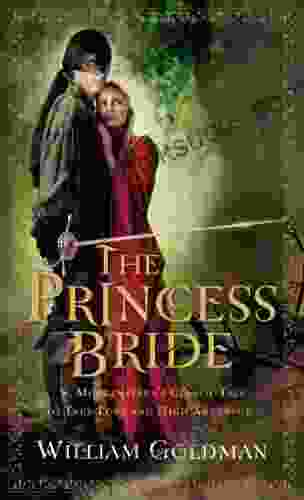
 Aldous Huxley
Aldous HuxleyMorgenstern: A Classic Tale of True Love and High...
Morgenstern is a...

 Beau Carter
Beau CarterThe Oasis Guide to Asperger Syndrome
What is Asperger Syndrome? Asperger...
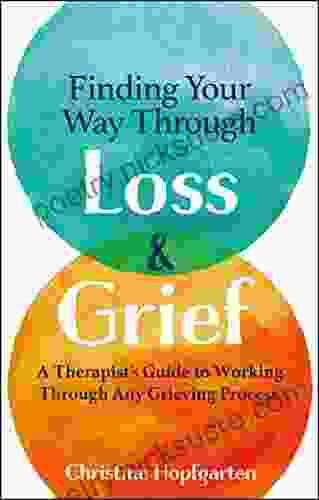
 Chadwick Powell
Chadwick PowellFinding Your Way Through Loss Grief: A Therapist S Guide...
Grief is a natural human emotion that we...
4.8 out of 5
| Language | : | English |
| File size | : | 3789 KB |
| Screen Reader | : | Supported |
| Print length | : | 199 pages |


